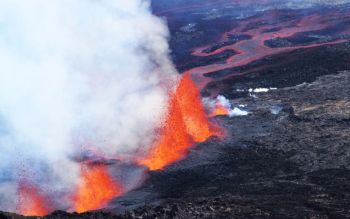Prøveforelesning - tid og sted
Fredag 31 januar, 10:15-11:00, Auditorium 1, Geologibygningen:
Geochemical constraints on compositional heterogeneity of the lower mantle
Kreeringssammendrag
I jordens indre fins strømmer av magma som stiger opp til overflate og forårsaker katastrofal vulkansk aktivitet, men det fins også andre strømninger som foregår over store avstander og lange tidsskalaer. Kjemiske variasjoner i mantelen vil påvirke strømningene, men kan ikke måles eller observeres direkte. Ved hjelp av numerisk simuleringer har Björn Heyn undersøkt hvordan strømninger fra prosesser på 2900 km dyp og nær jordas kjerne, kan forplante seg opp gjennom mantelen mot jordoverflaten.
Hovedfunn
Populærvitenskapelig artikkel om Heyns avhandling:
How Hawaiian-type volcanism is triggered in Earth’s deep interior
Our planet’s interior is actively convecting like boiling water in a pot, although on significantly larger length and time scales. In some locations, such as Hawaii and Iceland, one consequence of this convection is strong, long-lived volcanism that eventually creates island chains. But where does the erupted material come from, why is the volcano located at this specific spot, and what are the mechanisms to trigger this volcanism? To understand the origins of this Hawaiian-type volcanism, we have to dive deep into the interior of Earth, where the driving forces of convection are located.

This doctoral study uses numerical simulations to unravel how continent-sized piles of dense and potentially stiff material, residing about 2900 km beneath our feet, affect the formation of strong upwelling “plumes” that are thought to be associated with Hawaiian-type volcanism. Due to internal deformation, such piles periodically perturb a layer of hot material surrounding them, causing some material to rise and eventually erupt into volcanism. Moreover, this triggering mechanism causes a characteristic depression on the core-mantle boundary that may be used to constrain the properties of the deep Earth, and also locate newly emerging plumes before they erupt to the surface to produce Hawaiian-type volcanoes.
Foto og annen informasjon:
Pressefoto: Björn Holger Heyn, portrett; 150px. Foto: Geir Holm/UiO
Annet bildemateriale: An example of Hawaiian-type volcanism, here from the island of La Réunion in the Indian Ocean. Plume-related volcanoes remain active for millions of years as long as they are fed by processes deep within Earth’s interior.
Foto: Martin Mergili, distributed via imaggeo.egu.eu (link).
